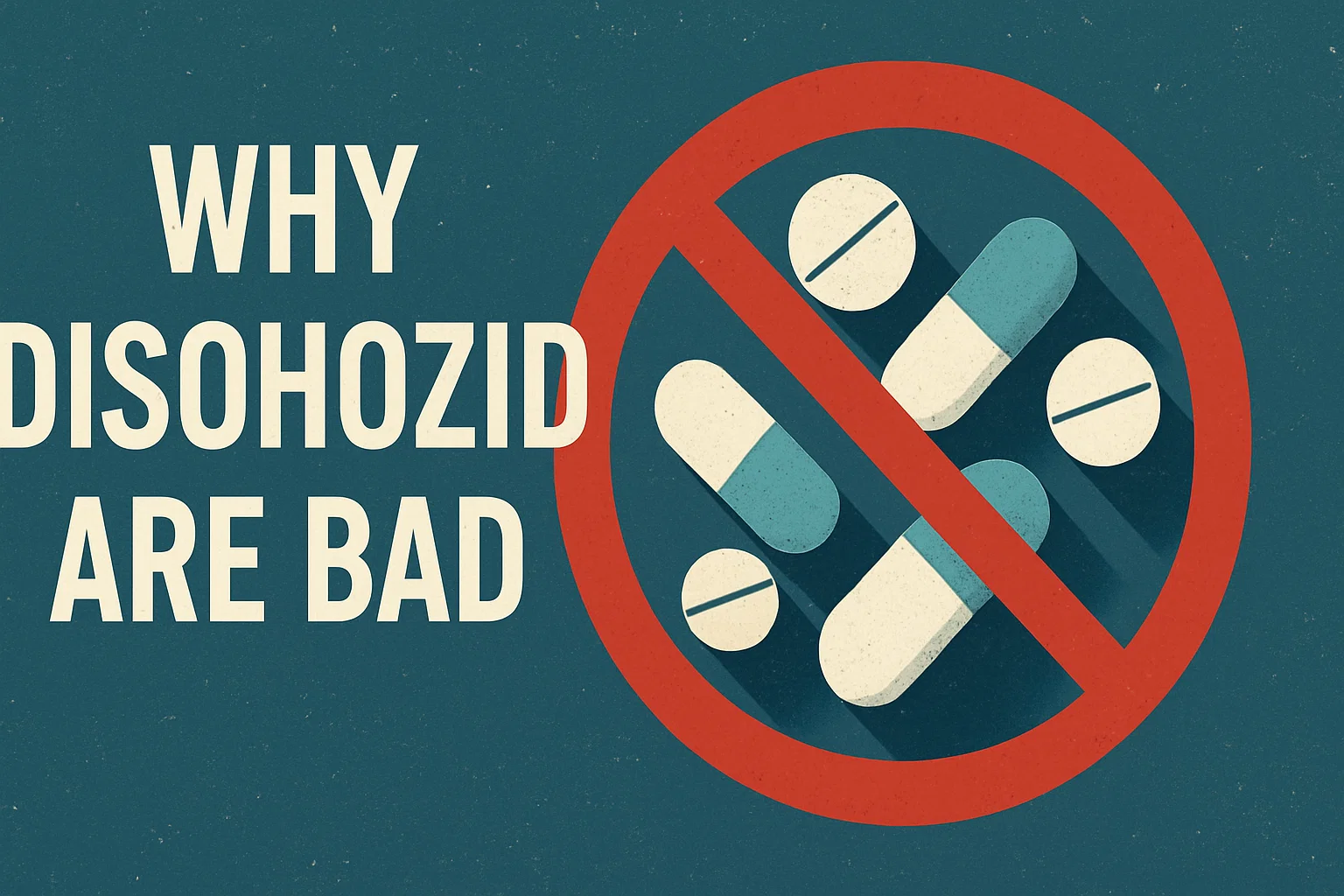Health
Why Disohozid Are Bad: The Hidden Dangers You Should Know

In today’s world, we come across hundreds of chemicals and synthetic compounds every day, many of which we know very little about. One such compound that has drawn attention is disohozid. People are now beginning to ask an important question — why disohozid are bad and what makes them potentially harmful. While the name may sound unfamiliar, understanding its effects is essential, especially for those who value their health and the environment.
This detailed article explores what disohozid actually is, how it affects the human body, what environmental issues it may cause, and how you can protect yourself from exposure. By the end, you’ll have a clear idea of why disohozid are bad and what steps can be taken to minimize risks.
What Are Disohozid?
Before discussing why disohozid are bad, it’s important to understand what this substance actually is. Disohozid is believed to be a type of synthetic compound created through chemical processes, often used in industrial applications, laboratory settings, or even as an ingredient in some manufacturing products. Because it is not naturally occurring, it does not integrate easily into natural biological systems, which is one of the main reasons it can cause harm.
Many synthetic compounds like disohozid are made to serve specific functions — for example, as stabilizers, preservatives, or chemical agents. However, when they enter the human body or the environment, they don’t always break down safely. This inability to decompose properly is one of the earliest signs that explain why disohozid are bad.
Health Risks: How Disohozid Affects the Human Body
When people question why disohozid are bad, the first concern that usually arises is health. Even small amounts of certain synthetic chemicals can cause serious damage to internal organs or body systems. Disohozid is suspected to have a range of harmful effects depending on the level and duration of exposure.
Toxicity Concerns
Disohozid can act as a toxic compound when introduced into the bloodstream. It may affect the liver and kidneys — the body’s main detoxification organs — leading to inflammation or reduced function. Prolonged exposure might cause cell damage or interfere with normal enzyme activity.
Allergic and Respiratory Reactions
Some individuals experience immediate allergic reactions after exposure. This can include skin irritation, redness, rashes, or respiratory distress. In more severe cases, contact with disohozid might trigger breathing difficulties, coughing, or chest tightness.
Nervous System Disruption
One of the lesser-known reasons why disohozid are bad is its potential to disturb the nervous system. Certain synthetic compounds can affect neurotransmitters — the brain’s chemical messengers — leading to mood changes, headaches, or fatigue. Long-term exposure might even impair memory or concentration.
Hormonal Imbalance
Another significant concern is endocrine disruption. Disohozid may mimic or block natural hormones in the body, particularly estrogen and testosterone. This can cause imbalances that lead to reproductive issues, irregular menstrual cycles, or changes in metabolism. Hormonal disruptions often take time to show symptoms, which makes them even more dangerous because people might not notice the harm until it becomes serious.
Environmental Impact: Why Disohozid Are Bad for Nature
Understanding why disohozid are bad isn’t limited to personal health — it’s also about protecting the environment. Many synthetic compounds like disohozid are not biodegradable, meaning they remain in soil, water, and air for long periods.
Soil and Water Contamination
When disohozid enters the ground, it can contaminate soil and affect plant growth. If it reaches groundwater or rivers, it can spread widely and impact both wildlife and human communities relying on those water sources. This contamination can make it difficult for ecosystems to recover, as disohozid compounds may take decades to break down.
Harm to Wildlife
Disohozid can also harm animals, especially aquatic species. Fish, amphibians, and other organisms might absorb the compound through their skin or food. Over time, these toxins can accumulate in their bodies — a process known as bioaccumulation — which then affects the entire food chain, including humans who consume contaminated fish or crops.
Air Pollution and Chemical Residue
Some forms of disohozid can evaporate into the atmosphere or bind with other pollutants, creating toxic air particles. Inhaling these particles can cause respiratory issues in both humans and animals. This is another strong reason why scientists emphasize why disohozid are bad for our planet’s long-term sustainability.
The Social and Ethical Concerns of Using Disohozid
Apart from the direct health and environmental effects, there are also social and ethical reasons why disohozid are bad. The production and use of harmful synthetic chemicals often involve industries that prioritize profit over safety. Many of these substances enter the market before being fully tested for their long-term impact on people or nature.
There is also the issue of waste management. In many developing regions, industrial waste containing disohozid might be dumped improperly, contaminating water sources and agricultural land. This disproportionately affects low-income communities and contributes to global inequality in environmental health.
Consumers also play a role. By purchasing products without understanding their ingredients, people unintentionally support industries that rely on toxic chemicals. Raising awareness about why disohozid are bad can help encourage ethical consumer behavior and push companies toward safer alternatives.
Safer Alternatives to Disohozid
Fortunately, there are ways to avoid or replace disohozid with less harmful options. As awareness grows, more industries are moving toward green chemistry — a field that focuses on creating products and processes that minimize toxicity and environmental damage.
Natural and Biodegradable Substances
One effective alternative is the use of natural or biodegradable compounds that can perform similar functions without long-term harm. For example, plant-based stabilizers or organic preservatives can often replace synthetic chemicals in various applications.
Strict Regulation and Testing
Governments and organizations can help by enforcing stricter regulations on chemical safety. Every compound, including disohozid, should undergo rigorous testing for toxicity, environmental impact, and long-term health effects before being approved for commercial use.
Public Awareness and Education
Another powerful tool is education. When people understand why disohozid are bad, they are more likely to demand safer products and support companies that adopt eco-friendly practices. Consumer awareness is one of the strongest forces in changing industry behavior.
How to Protect Yourself from Disohozid Exposure
Here are some practical steps to minimize your risk:
- Read labels carefully: Avoid products that contain complex synthetic ingredients unless you know they are safe.
- Choose natural alternatives: Whenever possible, go for organic or plant-based options.
- Ensure proper ventilation: If you work in environments with chemical exposure, make sure the area is well-ventilated.
- Support green companies: Buy from brands that are transparent about their ingredients and sustainability efforts.
- Dispose of waste responsibly: Never pour chemicals down the drain or into the ground.
By following these precautions, individuals can play a part in reducing the spread and impact of harmful compounds like disohozid.
Read also: The Mystery Behind 61285034690: What You Need to Know
Conclusion: Understanding Why Disohozid Are Bad Is the First Step Toward Change
In summary, why disohozid are bad can be understood through multiple lenses — health, environmental, ethical, and social. The compound poses risks that extend beyond immediate exposure, potentially affecting entire ecosystems and future generations. From toxic effects on the human body to contamination of soil and water, the dangers of disohozid are significant and cannot be ignored.
The good news is that awareness and action can make a real difference. By choosing safer alternatives, supporting responsible industries, and staying informed, we can help create a cleaner, healthier, and more sustainable world. Understanding why disohozid are bad isn’t just about avoiding a single compound — it’s about rethinking our relationship with chemicals as a whole and striving for balance between progress and protection.

-

 Celebrity6 months ago
Celebrity6 months agoWho Is Maria Dylan? The Untold Story of Bob Dylan’s Daughter
-

 Celebrity7 months ago
Celebrity7 months agoJelani Asar Snipes: The Rising Actor You Need to Know About
-

 Uncategorized7 months ago
Uncategorized7 months agoShannon Millard: Inspiring Success Stories and Achievements You Should Know
-

 Uncategorized7 months ago
Uncategorized7 months agoEverything You Need to Know About Stella Busina Matthews: A Comprehensive Guide
-

 Celebrity7 months ago
Celebrity7 months agoTimothy Byers Affleck: The Father Behind Ben and Casey Affleck
-

 Celebrity6 months ago
Celebrity6 months agoWho is Jane Elizabeth Ebsworth Oriel? The Untold Story of David Attenborough’s Wife
-

 Uncategorized6 months ago
Uncategorized6 months agoWho is Karima Jackson? The Untold Story of Ice Cube’s Daughter
-

 Uncategorized6 months ago
Uncategorized6 months agoDiscovering Andrea Skeete: A Rising Star in Personal Development and Community Engagement











